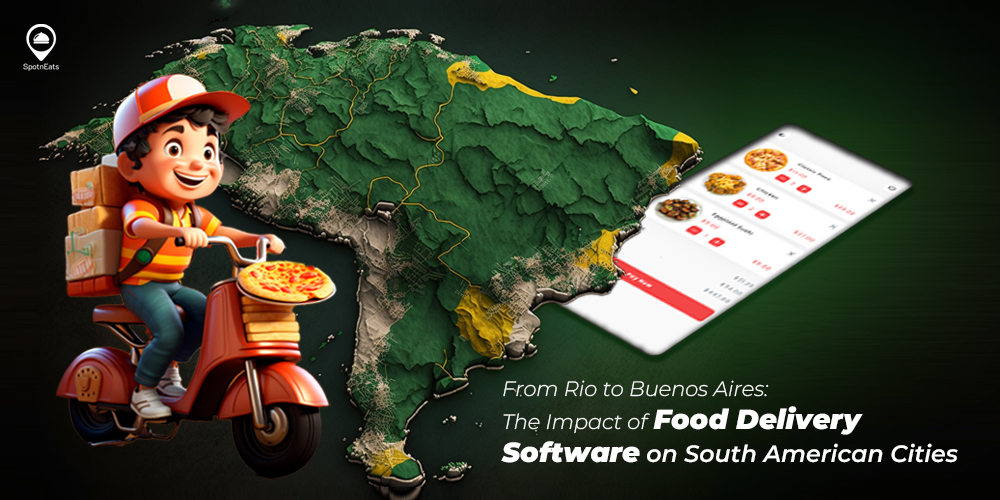
From Rio to Buenos Aires: The Impact of Food Delivery Software on South American Cities
The food industry has experienced tremendous growth all over the world. Its effect is reflected in South America for certain reasons. Factors such as diversified heritage, growing urbanization, internet penetration, and local businesses are the major reasons. This surge in demand has given rise to the need for advanced food delivery software. As the industry evolves, there are opportunities to shape the future of food delivery.
This article delves into the intricacies of food delivery software, driving business.
The Need for Food Delivery Software
For consumers with hectic schedules, having quality meals at their doorstep has become a necessity. Such a situation for food delivery needs to be streamlined with an app. An app increases the convenience of customers for the food business.
The ease of accessing a variety of cuisines through an app has contributed to the adoption of food delivery services. It provides an affordable and convenient alternative for a broad spectrum of consumers. By catering to different budget preferences.
Top aggregators
Following is a list of the top aggregators in the South American food industry.
DiDi Food
A Chinese-based establishment in Mexico started to expand in 2019 out of China. It soon crossed over 50000 hotel tie-ups and 80000 delivery partners for the business. And became the most downloaded app on all the platforms.
After the pandemic situation, many small eateries were connected to DiDi, and 56% of online sales through the app were recorded.
Domicilios.com
Domicilios is the start-up of two young university students. Found in 2007, it started as a food delivery industry and added a grocery delivery service to the company. They used the web and apps for the delivery. Use the mobile app to feel comfortable.
Glovo
Came into existence in 2015. Originating in Barcelona, it was later extended to Argentina, Chile, Bolivia, and Peru. Glovo transformed into a multiple-category app connecting users with stores and independent couriers. Offering on-demand services from local restaurants and stores in the city! Glovo enables anyone to get any product delivered in less than 60 minutes.
iFood
It is a local aggregator, a Brazilian start-up in 2011. iFood extended to Mexico, with a total of 25,000 connected eateries. It has now expanded to over 18 countries. This is most famous in South America and all over the world. It has 25 million customers.
Cornershop
Chile is a frontier place for Cornershop, founded in 2015. Following success, they extended their operations to Colombia, Mexico, Peru, Brazil, and Canada. To reach different people, they infused multi-currency, and multi-language into their apps
Rappi
It is one of the top performers in the South American region, operating in different places, like
Colombia, Argentina, Brazil, Chile, Mexico, Peru, Ecuador, Costa Rica and Uruguay.
They added engaging factors such as Rappi Favors, Rappi Pay, Rappi Mall, and Rappi Bets. To keep the customers engaged in apps and increase the user base for the business.
Pedidos Ya
A Uruguay-based food ordering business founded in 2009. As a result, Delivery Hero acquired it in 2014. Currently, the company operates in over 15 South American countries. In 2020, PedidosYa Market online launched, offering convenience pickup and delivery service.
Yummy
A Venezuelan delivery app later expanded services to Ecuador and Panama. Additionally, the app has diversified its offerings to other industries, such as ride-sharing, grocery delivery, and shopping. The company receives more than 70,000 orders a month, approximately.
Economic Impact
These food delivery software solutions have a significant impact on the economy. On the consumer side, food ordering apps can enhance convenience and accessibility. Consequently, this leads to an increase in overall spending on food services. Moreover, the digitalization of food services can contribute to a more streamlined supply chain. Additionally, they create job opportunities, stimulate local economies, and foster a robust ecosystem of culinary entrepreneurship.
User Experience and Accessibility
The platform hinges on providing a seamless user experience and enhancing accessibility. Moreover, intuitive interfaces, real-time tracking, and diverse payment options make food delivery a delight. This involves understanding user needs through comprehensive research. Subsequently, conducting user research aids in designing interfaces that are intuitive and easy to use. Moreover, users expect fast loading times and responsive interactions
Conclusion
The world of food delivery software has evolved into a dynamic and indispensable facet of modern living. South America is especially experiencing the effects of the food business. The aggregators commonly employ the mobile app as a tool for their development. Furthermore, this tool effectively leverages both customer and business experience. If you’re curious to explore further insights into the benefits of the food ordering software. Visit us!
Comments are closed.
